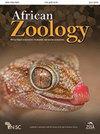Dietary Fibre Level Influence on Young Cane Rat Thryonomys swinderianus Growth and Digestive Health
IF 0.5
4区 生物学
Q4 ZOOLOGY
引用次数: 0
Abstract
The cane rat (Thryonomys swinderianus) is a wild animal recently domesticated in Africa for meat production. The effect of dietary fibre levels on the digestive health and growth in the young cane rat remains largely unknown. Dietary fibre intake, however, seems to play an important role in its digestive functioning. The aim of this study was to investigate the effect of dietary fibre intake on young cane rats. The estimated optimal dietary fibre content of pelleted diets, which optimised growth without impairing health in young T. swinderianus was examined. The feed intake, growth and health of young cane rats were assessed for four diets with dietary fibre levels set at 7, 12, 20 and 24% acid detergent fibre (ADF) on four groups of 18 animals each. Growth was best with the 12% ADF diet followed by 20% ADF diet, with average live weights reaching 1 404 g and 1 325 g, respectively, at 114 days of age. In contrast and compared with the 12% ADF diet, the 24% ADF diet resulted in a 9% weight reduction. Additionally, the 7% ADF diet led to a 33% mortality rate due to enteritis (without diarrhoea), but was associated with inflammation in the stomach and small intestine. We conclude that the optimal fibre content for growing cane rats fed on complete pelleted diets would be between 12% and 20%.膳食纤维水平对幼年甘蔗大鼠生长和消化系统健康的影响
甘蔗鼠(Thryonomys swinderianus)是最近在非洲被驯化用于肉类生产的野生动物。膳食纤维水平对幼鼠消化系统健康和生长的影响在很大程度上仍然未知。然而,膳食纤维的摄入似乎在其消化功能中起着重要作用。本研究的目的是探讨膳食纤维摄入量对幼龄甘蔗大鼠的影响。研究了颗粒饲料的最佳膳食纤维含量,该饲料在不损害幼年猪的健康的情况下优化了猪的生长。采用日粮纤维水平分别为7%、12%、20%和24%的四组饲粮,每组18只,对甘蔗幼龄大鼠的采食量、生长状况和健康状况进行了评价。12% ADF组生长最好,其次是20% ADF组,114日龄时平均活重分别为1 404 g和1 325 g。与12% ADF的饮食相比,24% ADF的饮食导致体重减轻9%。此外,7% ADF饮食导致33%的肠炎死亡率(无腹泻),但与胃和小肠炎症有关。综上所述,饲喂全颗粒饲料的甘蔗生长大鼠的最佳纤维含量为12% ~ 20%。
本文章由计算机程序翻译,如有差异,请以英文原文为准。
求助全文
约1分钟内获得全文
求助全文
来源期刊

African Zoology
生物-动物学
CiteScore
2.60
自引率
9.10%
发文量
18
审稿时长
>12 weeks
期刊介绍:
African Zoology , a peer-reviewed research journal, publishes original scientific contributions and critical reviews that focus principally on African fauna in terrestrial, freshwater, and marine ecosystems. Research from other regions that advances practical and theoretical aspects of zoology will be considered. Rigorous question-driven research in all aspects of zoology will take precedence over descriptive research. The Journal publishes full-length papers, critical reviews, short communications, letters to the editors as well as book reviews. Contributions based on purely observational, descriptive or anecdotal data will not be considered.
The Journal is produced by NISC in association with the Zoological Society of South Africa (ZSSA). Acceptance of papers is the responsibility of the Editors-in-Chief in consultation with the Editors and members of the Editorial Advisory Board. All views expressed are those of the author and not necessarily those of the Editors or the Department.
 求助内容:
求助内容: 应助结果提醒方式:
应助结果提醒方式:


